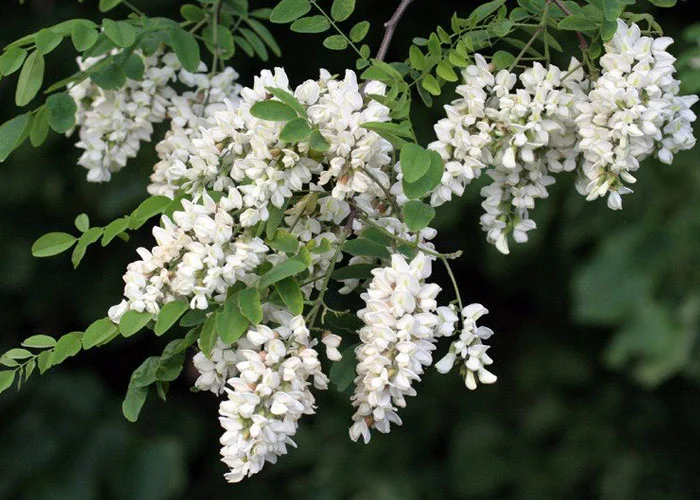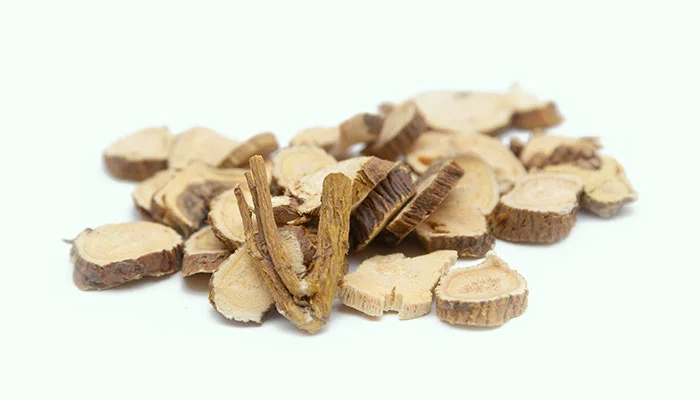What Is Ku Shen
Ku Shen also known as Radix Sophorae Flavescentis is the root of Sophora Flavescens, which is a deciduous shrub belonging to the family Leguminosae. It has a medicinal history of more than 2,000 years.
This plant often grows on hillsides, grass slopes, or shrubs below 1,500 meters above sea level. It can be found in Russia, Japan, India, North Korea, and China. Its seeds can be made into pesticides, and its bark can be made into sacks.
In spring and autumn, people gather the roots of Sophora Flavescens, remove their fibrous roots and root tips, wash them with water, cut them into pieces, dry them in the sun, and make them into Chinese herbal medicines.

Ku Shen contains a variety of alkaloids, such as matrine, oxymatrine, isomatrine, allomatrine, cis-neomatrine, trans-neomatrine, sophocarpine, oxysophocarpine, sophoridine, isosophoridine, sophoranol, sophoranol N-oxide, anagyrine, cytisine, isosophocarpine, and flavascensine. In addition, it also contains flavonoids, phenylpropanoids, saponins, lupenone, β-amyrin, β-sitosterol, fatty acids, and amino acids.
Generally, the Ku Shen with an extremely bitter taste and yellow-white cross-section is preferred.
According to the Chinese Pharmacopoeia, the medicinal nature of Ku Shen is relatively cold, with a bitter taste. It has a certain therapeutic effect on the pathological changes of the heart, liver, stomach, large intestine, and bladder meridians.
In traditional Chinese Medicine, it is often used to clear heat and dry dampness, kill worms, promote urination, and treat acute icteric hepatitis, chronic proctitis, viral myocarditis, acute bacterial dysentery, mycotic enteritis, chronic ulcerative colitis, esophagitis, tonsillitis, cervicitis, pelvic inflammation, vaginitis, neurodermatitis, scald, gonorrhea, arrhythmia, insomnia, and asthma.
There are more than 100 kinds of traditional Chinese medicine prescriptions containing it, such as Ku Shen Tang, Xiao Feng San, Hua Zhi Pian, and Danggui Kushen Wan.
Benefits
- Inhibiting hepatitis B virus and HPV virus.
- Anti-inflammation, inhibiting xylene-induced mouse ear swelling and carrageenan-induced rat foot swelling.
- Increasing the number of white blood cells, enhancing the phagocytic activity of white blood cells, and inhibiting T cell proliferation.
- Inhibiting the synthesis of collagen in the liver, reducing the abnormal proliferation of liver extracellular matrix and lipid peroxidation.
- Inhibiting the proliferation of human liver cancer cell lines HepC2 and QGY in vitro, and inducing apoptosis of ovarian cancer SKOV3 cells.
- Clearing damp-heat in the stomach and large intestine, treating bacillary dysentery, and diarrhoea caused by damp-heat.
- Treating bloody dysentery, hematochezia, hemorrhoidal hemorrhage, and jaundice caused by damp-heat.
- Treating genital swelling and itching, morbid leukorrhea caused by damp-heat.
- Relieving skin itching and treating eczema, rubella, and scabies.
- Inducing diuresis, treating difficult urination, burning sensation during urination, and urinary pain caused by damp-heat.
- Its injection can antagonize the arrhythmia caused by aconitine.
- Its total alkaloids can inhibit the heart, slow down the heart rate, weaken myocardial contractility, and reduce cardiac output.
- Studies have found that both matrine and sophocarpine can affect the body temperature regulation center and lower the normal body temperature.
- Matrine can enhance the contractility of the isolated guinea pig’s right atrium and has a positive inotropic effect on the isolated guinea pig’s right ventricular papillary muscle.
- Inhibiting Staphylococcus aureus, Pseudomonas aeruginosa, Streptococcus A, Streptococcus B, Mycobacterium tuberculosis, Escherichia coli, Shigella, Staphylococcus epidermidis.
Combinations
- It can be used in combination with Liu Huang (Sulfur), Ku Fan (Dried Alum), etc. to treat scabies.
- It can be used in combination with Sheng Di Huang (Radix Rehmanniae), etc. to treat hematochezia and hemorrhoid bleeding caused by damp-heat.
- It can be used in combination with She Chuang Zi (Fructus Cnidii), Huang Bai (Cortex Phellodendri), etc. to relieve itching and treat eczema.
- It can be used in combination with Shi Wei (Folium Pyrrosiae), Che Qian Zi (Semen Plantaginis), Zhi Zi (Fructus Gardeniae), etc. to promote urination, treat difficult urination, burning sensation during urination, and urinary pain caused by damp-heat.
- It can be used in combination with Yu Zhu (Rhizoma Polygonati Odorati), Zhi Gan Cao (Radix Glycyrrhizae Preparata), Wu Wei Zi (Fructus Schisandrae), Dan Shen (Radix et Rhizoma Salviae Miltiorrhizae), Shan Zha (Hawthorn Fruit), etc. to treat viral myocarditis.
Side Effects
- Animal experiments show that its alkaloids can cause cramps and respiratory paralysis. Rabbits can cause breathing difficulties and cause death after intravenous injection of its alkaloids.
- A small percentage of people taking it may stomach pain, heartburn, nausea, vomiting, loose stools, or loss of appetite.
Precautions and Warnings
- The dosage of Ku Shen should be controlled at 3-10g.
- It can be made into decoctions, lotions, pills, or powder.
- People who are allergic to Ku Shen should not take it.
- It should not be taken at the same time as Li Lu (Veratrum nigrum), Chuan Bei Mu (Fritillaria Cirrhosa), Lou Lu (Radix Rhapontici), or Tu Si Zi (Semen Cuscutae).
- Patients with deficiency-cold in the spleen and stomach should not take it.
- Patients with fever, the body feeling cold, and diarrhea should not take it.
- Pregnant and breastfeeding women should not take it.
- Children, the elderly, and the infirm should not take it.
